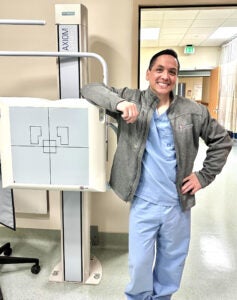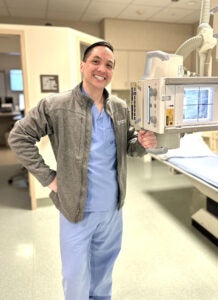Although Nathaniel Montiel had plenty of college experience before enrolling in Boise State University’s online Bachelor of Science in Imaging Sciences program, he wanted more to show for his hard work.

“I have always enjoyed going to school, so I would take a class here or take a class there for different jobs,” he said. “I have over 100 credits and two associate degrees from all of these classes. This program is perfect for me because it gives me a chance to bring it all together.”
The decision to return to higher education paid off for Montiel, a radiologic technologist at El Camino Hospital in Mountain View, California. He earned a $5,800 Parsons Degree Achievement Scholarship from the American Society of Radiologic Technologists Foundation during his first semester in 2023. The scholarship was created to help established radiologic technologists earn their college degree.
This scholarship, plus additional funding from his employer and union, closed the gap almost entirely and made pursuing a bachelor’s possible for Montiel.
“It wasn’t an easy task,” he said. “I was amazed when I got the email. I originally planned to pay for everything on my own, which was the goal I had in mind. This is meant to happen, for sure.”
Montiel credits the asynchronous online format and being able to complete coursework anytime and anywhere, as another factor that has made pursuing his degree possible. Taking all of his courses fully online helps him balance school with his work and personal life without sacrificing his experience in the program. While the program offers flexibility around his schedule, students still have numerous opportunities to engage with each other, faculty and program staff – many of whom have experience in the field of imaging.
“You don’t feel disconnected because you’re always checking in,” he said. “Boise State creates that with group projects and discussions, so you still feel connected.”
Coming Into Focus
Montiel is from the San Francisco Bay Area, where he planned to become a personal trainer before switching gears and becoming a paramedic. He has an associate degree in human development studies from Ohlone College and an associate degree in emergency medical technology from the College of Emergency Services.
“I wanted a job where I was helping people and outside a lot,” he said. “You do that as a paramedic. You’re embedded in the community. You never know where you’re going to end up. If you like controlled chaos, that’s a great job.”
After working in the field for a few years, however, Montiel wanted to take on a new challenge within the healthcare field.
“I would take patients with fractures and other trauma to the emergency room,” he said. “I always wondered what was going on in the patients’ bodies that I couldn’t see.
“There’s a whole modality, a genre of medicine dedicated to what’s going on inside of the patient. That was the missing link in fixing the patient. Seeing injury after injury got me interested in radiology.”
Montiel earned his American Registry of Radiologic Technologist (ARRT) credential to grow his career in radiology. That set him up for the Bachelor of Science in Imaging Sciences program, and even though he hasn’t been in the program for long, he has already gained valuable knowledge from the curriculum.
“The first course I took, Civil Engagement, Ethics and Global Diversity, was all about leadership,” he said. “That applies because I want to go into administration one day. Leadership applies to any position. I also learned about research papers and professionalism.
In the imaging course I just finished, we did a group paper about what equipment we would choose if we were running our own department. What’s funny is we had just bought new equipment at the hospital where I work. It couldn’t have been more applicable.”
Because of Montiel’s previous college credits and the 25 credits the program awards students for a completed ARRT credential, he has a jump on completing the bachelor’s degree and is on track to graduate in December 2024.
“The big exam that we take, the ARRT, turns into credits,” he said. “In addition to the prerequisites I took for paramedic and radiography, I take 30 units of imaging courses and get a bachelor’s degree in the end.”
Boise State’s imaging sciences program is a degree completion option for students who have a completed associate degree and ARRT or equivalent national credential. With seven-week courses available, students can complete their degree in as few as 12 months.
Picture Perfect
Once Montiel graduates from Boise State, he will focus on advancing his career with an expanded knowledge base. His next step is moving into administration, education, research and technology.
“Administration is a natural progression for me in the field. This degree will definitely open up those opportunities for me. This program fills in a lot of the gaps. X-Ray school focused on imaging, procedures and the science. Boise State’s program goes over the extracurricular, like administration, things you aren’t taught in X-ray school.”

Montiel, who enjoys exercising, meditation and making electronic music in his free time, has received encouragement from his friends, family and colleagues in his return to higher education.
“I have a lot of support from my family,” he said. “I have also got a lot of co-workers interested in the program. My co-workers all know Boise State and the Broncos.”
Now that Montiel is on his way to earning his bachelor’s degree, he is eager to check a major accomplishment off of his list of goals.
“Finishing my bachelor’s degree isn’t to make more money,” he said. “I already have a job and make decent money but I have always felt incomplete.
“This program is perfect. It makes me feel good about all of these courses I took over the years. It lets me bring it together with something to show for it at the end.”
Learn More About Imaging Sciences
Want to learn more about the Imaging Sciences program? Join us for an online information session or contact a student success coach.